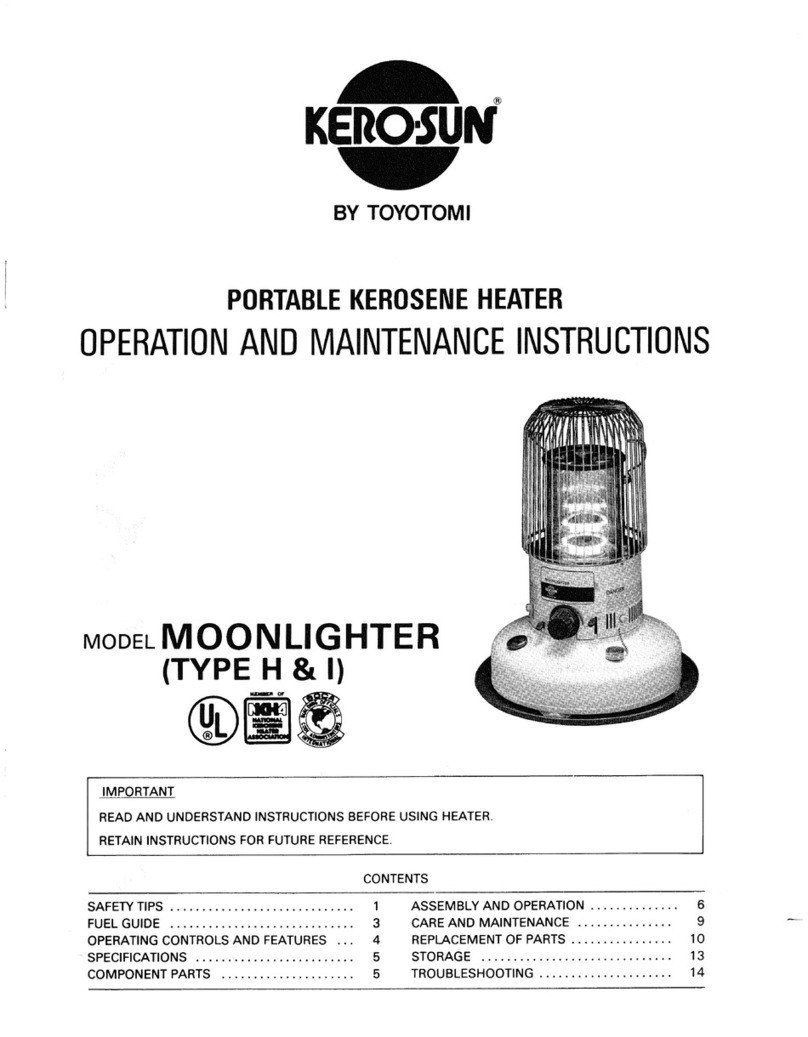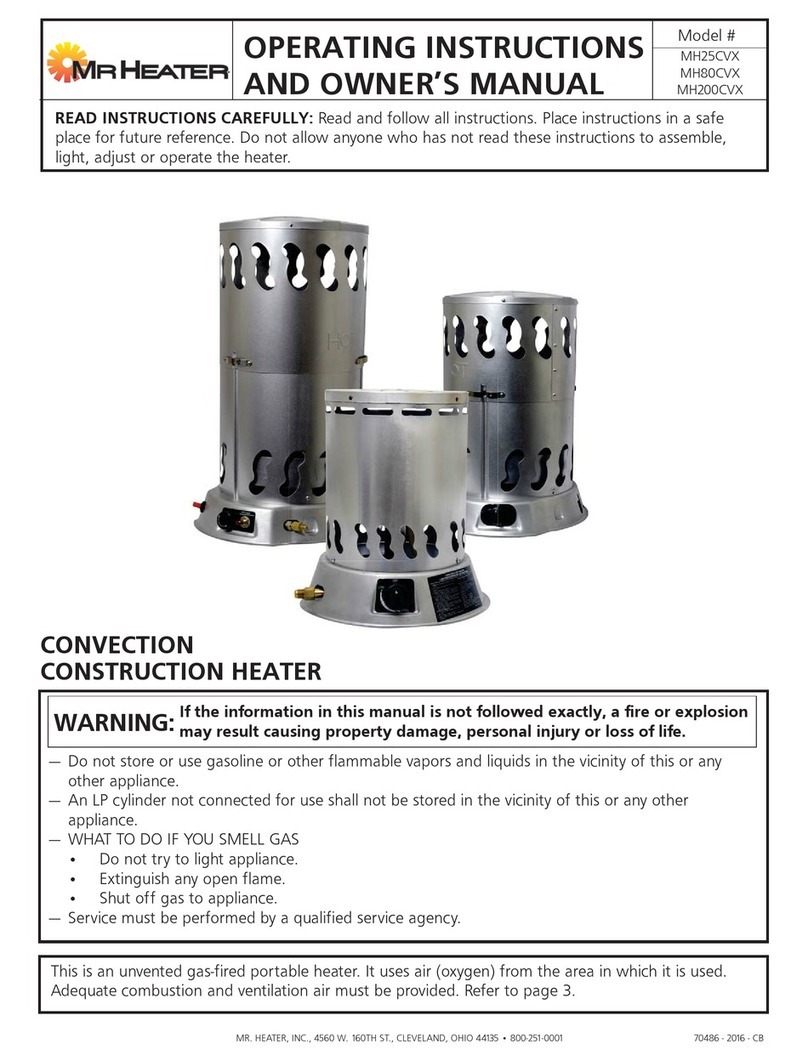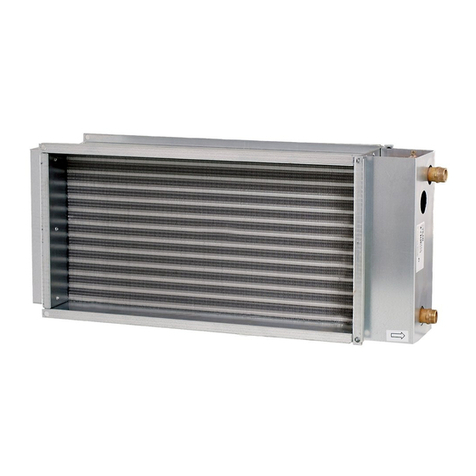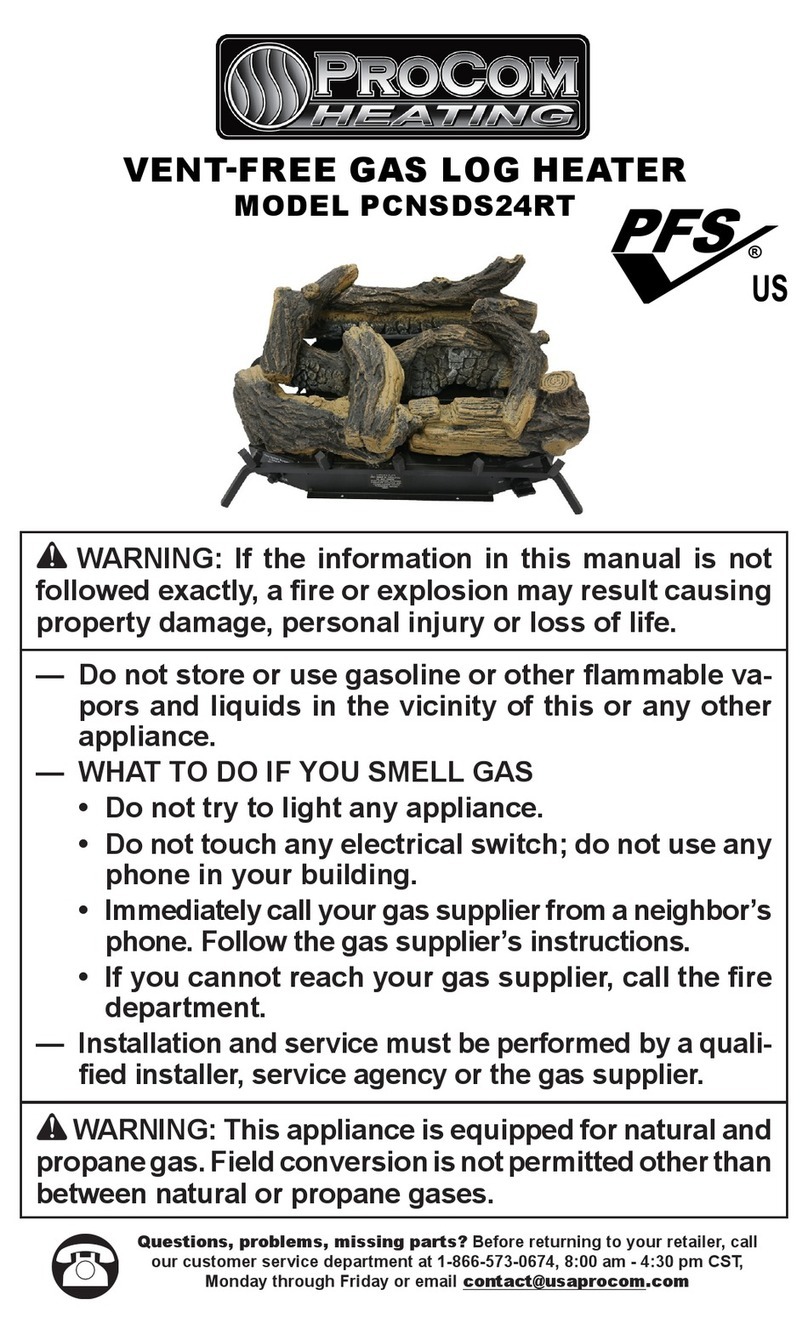GASLAND chef MHA18B User manual

3330-A Marathon Ct Charleston, SC 29418
1 (844) 538-7890
www.gaslandchef.com
Available Model
MHA18B
CABINET HEATER
Installation Instructions

www.gaslandchef.com
3330-A Marathon Ct Charleston, SC 29418
01
1 (844) 538-7890
DANGER
GENERAL HAZARD WARNING:
FAILURE TO COMPLY WITH THE PRECAUTIONS AND INSTRUCTIONS PROVIDED WITH THIS HEATER, CAN
RESULT IN DEATH,SERIOUS BODILY INJURY AND PROPERTY LOSS OR DAMAGE FROM HAZARDS OF FIRE,
EXPLOSION, BURN. ASPHYXIATION, CARBON MONOXIDE POISONING AND / OR ELECTRIC SHOCK.
ONLY PERSONS WHO CAN UNDERSTAND AND FOLLOW THE INSTRUCTIONS SHOULD USE OR SERVICE THIS
HEATER. IF YOU NEED ASSISTANCE OR HEATER INFORMATION SUCH AS AN INSTRUCTIONS MANUAL, LABEL,
ETC. CONTACT THE MANUFACTURER.
WARNING
FIRE, BURN, INHALATION, AND EXPLOSION HAZARD. KEEP SOLID COMBUSTIBLES, SUCH AS BUILDING
MATERIALS, PAPER OR CARDBOARD, A SAFE DISTANCE AWAY FROM THE HEATER AS RECOMMENDED BY
THESE INSTRUCTIONS. NEVER USE THE HEATER IN SPACES WHICH DO OR MAY CONTAIN VOLATILE OR
AIRBORNE COMBUSTIBLES, OR PRODUCTS SUCH AS GASOLINE, SOLVENTS, PAINT THINNERS, DUST
PARTICLES OR UNKNOWN CHEMICALS. KEEP ALL COMBUSTIBLE MATERIALS, GASOLINE, AND OTHER
FLAMMABLE VAPORS AND LIQUID AWAY FROM THIS HEATER.
Safety Information ..................................................................................................................................................
Specifications .........................................................................................................................................................
Features .................................................................................................................................................................
Packing List ............................................................................................................................................................
Unpacking ..............................................................................................................................................................
Assembly ................................................................................................................................................................
Operation ...............................................................................................................................................................
Ventilation ...............................................................................................................................................................
Storage and Maintenance ......................................................................................................................................
Troubleshooting Guide ...........................................................................................................................................
Exploded View .......................................................................................................................................................
Warranty .................................................................................................................................................................
02 - 04
04
05
05
06
06 - 07
07 - 09
10
10
11
11 - 12
12
Contents

www.gaslandchef.com
3330-A Marathon Ct Charleston, SC 29418
1 (844) 538-7890
02
DANGER
Carbon Monoxide Hazard
This heater produces carbon monoxide, which has no
odor. Burning the heater in an enclosed space can kill
you. Never use the heater in enclosed spaces such as a
tent, a camper, any vehicle or recreational vehicle (RV),
enclosed shelter, or any other enclosed areas.
DANGER
If the information in this manual is not followed exactly, a
fire or explosion may result causing property damage,
personal injury or loss of life.
WARNING
NOT FOR HOME OR RECREATIONAL VEHICLE USE.
DANGER
Not for use in residential living areas or in non-adequately
ventilated enclosed spaces. Never bring or store a
propane cylinder indoors.
WARNING
DO NOT OPERATE THIS HEATER UNTIL YOU HAVE
READ AND THOROUGHLY UNDERSTAND THESE
SAFETY AND OPERATING INSTRUCTIONS.
Failure to comply with the precautions and instructions
provided with this heater can result in death, serious bodily
injury, property loss or damage from the hazards of fire,
explosions, burns, asphyxiation or carbon monoxide
poisoning. Only persons who can read and understand
these instructions should use or service this heater.
WARNING
This is an unvented portable heater. It uses air (oxygen)
from the area in which it is used. Adequate combustion
and ventilation air must be provided. Refer to VENTILA-
TION on Page 10.
WARNING
EXTREMELY HOT DURING OPERATION! Do Not touch
any metal components while in operation. Keep all
combustible materials, gasoline, and other flammable
vapors and liquid away from this heater.
WARNING
RISK OF INDOOR AIR POLLUTION!
DANGER
CARBON MONOXIDE POISONING MAY LEAD TO DEATH!
WARNING
This product can expose you to chemicals, including lead,
which is known to the State of California to cause cancer
and birth defects or other reproductive harm. For more
information go to www.P65Warnings.ca.gov.
The products described in this manual are propane direct-fired, forced air heaters. Propane forced air heaters are primari-
ly intended for use for temporary heating of buildings under construction, alteration or repair. Direct-fired means that all of
the combustion products of the heater enter the heated space. This appliance is rated at 98% combustion efficiency, but
does produce small amounts of carbon monoxide.
Carbon monoxide is toxic. Humans can tolerate only small amounts of carbon monoxide and so precautions should be
taken to provide proper ventilation. Failure to provide proper ventilation in accordance with the instructions in this manual
can result in death.
People with breathing problems should consult a physician before using this heater.
Early signs of carbon monoxide poisoning resemble the flu. Symptoms of improper ventilation / carbon monoxide
poisoning are:
Headache • Dizziness • Nausea • Dry Mouth Sore Throat • Burning of Nose and Eyes
If you experience any of these symptoms:
GET FRESH AIR AT ONCE! Have your heater serviced and check for proper ventilation. Some people are more affected
by carbon monoxide than others. These include: pregnant women, those with heart or lung problems, anemia or those
under the influence of alcohol or at high altitudes.
FOR INDOOR USE ONLY:
Adequate ventilation shall be provided in accordance with OSHA 29 CFR 1926.154, Safety Requirements for Temporary
and Portable Space Heating Devices and Equipment, ANSI A10.10, ANSI Z223.1/NFPA 54 Liquefied Petroleum Gas
Code, NFPA 58 or the Natural Gas and Propane Installation Code, CAN B149.1 as appropriate.
Safety Information

www.gaslandchef.com
3330-A Marathon Ct Charleston, SC 29418
03
1 (844) 538-7890
DANGER
PROPANE IS AN EXPLOSIVE GAS.
WARNING
RISK OF BURNS, FIRE AND EXPLOSION!
WARNING
AIR QUALITY HAZARD WARNING
CAUTION! HOT WHILE IN OPERATION. DO NOT TOUCH. KEEP CHILDREN,
ANIMALS, CLOTHING AND COMBUSTIBLES AWAY FROM HEATER.
WHAT TO DO IF THE SMELL OF GAS IS PRESENT:
– DO NOT attempt to light the heater.
– Extinguish any open flame.
– Shut off gas to heater.
– If odor continues, contact your local gas supplier or fire department.
– DO NOT touch or use any electric switch or any electric device that can cause a spark.
– Immediately call your gas supplier from a neighbors phone. Follow the gas suppliers instructions.
– If you can not reach your gas supplier, call the fire department.
– Service must be done by a qualified service agency.
NEVER store or use gasoline or other flammable vapors and liquids in the vicinity of this heater.
NEVER store a propane (LP) cylinder not connected to this heater in the vicinity of this heater.
NEVER connect heater to an unregulated gas supply.
NEVER obstruct the flow of combustion and ventilation air.
NEVER use duct work in front or rear of heater.
NEVER modify this heater or operate a heater that has been modified.
NEVER service, move or handle heater while still hot or operating
Keep all combustible materials, gasoline, and other flammable vapors and liquid away from this heater.
– Do not use this heater for heating human living quarters.
– Use of direct-fired heaters in the construction environment can result in exposure to levels of CO, CO2, and NO2
considered to be hazardous to health and potentially life threatening.
– Do not use in unventilated areas.
– Know the signs of CO and CO2poisoning.
• Headaches, stinging eyes.
• Dizziness, disorientation.
• Difficulty breathing, feels of being suffocated.
– Proper ventilation air exchange (OSHA 29 CFR 1926.57) to support combustions and maintain acceptable air quality
shall be provided in accordance with OSHA 29 CFR Part 1926.154, ANSI A10.10 Safety Requirements for Temporary
and Portable Space Heating Devices and Equipment used in the Construction Industry or the Natural Gas and Propane
Installation Codes CSA B149.1.
– Periodically monitor levels of CO, CO2and NO2existing at the construction site – at the minimum at the start of the shift
and after 4 hours.
– Provide ventilation air exchange, either natural or mechanical, as required to maintain acceptable indoor air quality.
– Ensure that the flow of combustion and ventilation air exchanges cannot become obstructed.
– As the building “tightens up” during the construction phase ventilation may need to be increased.
Minimum Clearance From Combustibles
Front
40 in.
Sides
16 in.
Top
40 in.
USA 8-Hr Time weighted average
(OSHA 29 CFR 1926.55 App A)
CO
Canada 8-hr time weighted average WorkSafe
BC OHS Guidelines Part 5.1 and Ontario
Workplaces Reg 833
CO2
NO2
CO
CO2
NO2
50 ppm
5000 ppm
25 ppm
5000 ppm
3 ppm (Reg 833)

www.gaslandchef.com
3330-A Marathon Ct Charleston, SC 29418
1 (844) 538-7890
04
WARNING
For use with propane (LP) gas only.
WARNING
The hose assembly shall be protected from traffic, building material and contact with hot surfaces both during use and
while in storage.
WARNING
RISK OF FIRE! ALWAYS LOCATE HEATER ON A STABLE AND LEVEL SURFACE!
– ALWAYS install the heater so that it is not directly exposed to water spray, rain, dripping water, or wind.
– Use heater in accordance with all local codes and with CSA 5.90 U.S. (5th Ed.) Infrared Patio Heater.
– This heater is shipped from the factory for use with propane (LP) gas only. Do not convert to any other gas. Installation
must conform to local codes, or in their absence, with the standard for the Storage and Handling of Liquefied Petroleum
Gases ANSI/NFPA 58 and the Natural Gas and Propane Installation Code CSA B149.1.
– Gas supply connections should be checked by using a 50/50 soap and water solution. Never use a flame to check for
gas leaks.
– Use only the regulator and hose assembly provided with this heater. Inspect the regulator/hose assembly prior to each
use of the heater. If there is excessive abrasion or wear, or if the hose is cut, replace it with the proper assembly shown in
the parts list, prior to using the heater. The replacement hose assembly should follow manufacturer's specification.
– This heater is not for use on finished floors.
Minimum and Maximum Inlet Pressure
Model
Min.
Max.
MHA18B
5 PSI
Bottle Pressure
Model
BTU
Fuel Consumption (lb./hr)
Heat Settings
Maximum Operating Hours
Required Cylinder Lbs.
Fuel Type
Heating Area (Ft.2)
MHA18B
6,000 / 12,000 / 18,000
0.29 /0.57 / 0.86
3
69 / 35 / 23
20
Use ONLY 20 lb. LP Gas Cylinder: 18" x 12.25"
150 / 300 / 450
5 ppm
100 ppm
15000 ppm (WSBC)
30000 ppm (Reg 833)
1.0 ppm (WorkSafeBC)
5.0 ppm (Reg 833)
USA – Ceiling Limit
(Short Term Exposure Limit = 15 minutes)
Canada STEL (15 minutes Reg 833/1 hour
WSBC) WorkSafe BC OHS Guidelines Part 5.1
and Ontario Workplaces Reg 833
CO
CO2
NO2
CO
CO2
NO2
Specifications

www.gaslandchef.com
3330-A Marathon Ct Charleston, SC 29418
05
1 (844) 538-7890
Features
Packing List
Safety Guard
Piezo
Valve Knob
Handle Slot
Protective Guard
Front Castor
Rear Castor
Heater Cabinet Hose and Regulator

www.gaslandchef.com
3330-A Marathon Ct Charleston, SC 29418
1 (844) 538-7890
06
WARNING
The Propane (LP) gas pressure regulator and hose assembly supplied with the heater must be used without alteration.
CAUTION
The Propane (LP) gas pressure regulator and hose assembly supplied with the heater must be used without alteration.
CAUTION
Be sure to inspect the regulator hose before each use. If the hose is cut or frayed, replace it with the manufacturer
suggested assembly.
Unpacking
1. Remove all packing items applied to heater for shipment. Keep plastic cover caps attached to inlet connector and hose
/ regulator assembly for storage.
2. Remove all items from carton
3. Check all items for shipping damage. If the heater is damaged, promptly inform dealer where you purchased the
heater.
Assembly
1. Place heater on a flat surface.
2. Fold propane tank tray down (see Figure 1)
3. Attach Protective Guard.
4. Inspect heater closely for any damage that may have occured during shipping. If there is any damage, return the
heater to place of purchase.
Connecting to Gas Supply
IMPORTANT! - Always use a propane (LP) cylinder that has a connection device compatible with the hose and regulator
assembly supplied.
1. Remove the back cover by sliding the cover straight up and away from the heater body. Place the LP cylinder on the
bottom plate and replace the back cover.
2. To connect LP cylinder, insert regulator end fitting into cylinder valve, rotate coupling nut clockwise and tighten firmly
(see Figure 2).
3. Open valve on propane cylinder slowly. If the valve is not opened slowly, the excess flow check valve in the regulator
will stop the flow of gas. If this should happen, close the valve, wait one minute (or until you hear the valve click), and
re-open, slowly.
4. Be sure to inspect all connections for leaks, by using a 50/50 mixture of dish soap and water on all connection.
Any bubbles forming indicate a leak.
Figure 1
Protective
Guard

www.gaslandchef.com
3330-A Marathon Ct Charleston, SC 29418
07
1 (844) 538-7890
CAUTION
Propane is safe to use when properly handled. Careless handling of the LP cylinder could result in a fire and or an
explosion.
CAUTION
The disconnected tank must never be stored in a building, garage or any other enclosed area.
Operation
Propane Supply / Information: Propane (LP)
This heater is not supplied with a propane cylinder. Use only an approved propane cylinder.
LP Characteristics
– Flammable, explosive under pressure, heavier than air and pools in low areas.
– In its natural state, propane has no odor, but for your safety an odor that smells like rotten cabbage has been added.
– Contact of propane (LP) gas with the skin can cause freeze burns.
– Heater is manufactured for use with propane gas only. DO NOT attempt to convert to any other gas. Such modifications
are dangerous and will void the warranty.
– When heater is not in use, LP Cylinder must be turned OFF.
– Be sure that the LP Cylinder is located on a level and stable surface.
– DO NOT use this heater in a basement or below ground level. Propane is heavier than air and will always seek the
lowest level. If you suspect a leak, shut off the valve at the LP Cylinder immediately.
The Propane (LP) cylinder must also be equipped with the following:
– A collar to protect the gas valve.
– A shut-off valve terminating a LP cylinder valve outlet as specified in the American National Standard for Compressed
Gas Cylinder Valve Outlets and Inlets Connections.
– A safety relief valve having direct communications with the vapor space of the LP cylinder.
– The heater must operate on vapor withdrawal from the operating cylinder.
– Always keep LP cylinder fastened and upright.
– Avoid tipping the LP cylinder on its side when connected to a regulator, since this may cause damage to diaphragm in
the regulator.
– Handle valves with care.
– Never connect an unregulated LP cylinder to a construction heater.
– DO NOT subject LP cylinder to excessive heat.
– Tightly close the gas shutoff valve on the LP cylinder after each use.
– All fittings must be protected when disconnected from the LP cylinder.
– Never store an LP cylinder inside a building or in the vicinity of an gas burning appliances.
Figure 2
Regullator
Coupling Nut
LP Cylinder Valve

www.gaslandchef.com
3330-A Marathon Ct Charleston, SC 29418
1 (844) 538-7890
08
WARNING
Purging and filling of the LP cylinders must be performed by personnel who have been thoroughly trained in accepted
LP gas industry procedures. Failure to follow these instructions may result in explosion, fire, severe personal injury or
death.
WARNING
EXTREMELY HOTduring operation. Do Not touch any metal components while in operation. Keep gasoline and any
other flammable liquids away from the heater.
Pre-Lighting Instructions: Connecting the LP Cylinder
ALL NEW LP CYLINDERS MUST BE PURGED BEFORE THE FIRST FILLING.
– Turn heater gas valve knob and LP cylinder valve to OFF position.
– LP cylinder valve equipped with old style fitting has LEFT HANDED THREADS. Turn fitting CLOCKWISE to loosen.
Protect this fitting when disconnected from LP cylinder.
– Have your LP cylinder filled by your local propane gas supplier.
– Some LP cylinders have a bleed-OFF valve. This valve should be inspected for leaks after each filling of the LP
cylinder. Turn the valve clockwise to close.
– Fasten full propane tank and connect proper fitting to LP cylinder valve by turning COUNTERCLOCKWISE.
– With heater gas valve knob still in OFF position turn ON the LP cylinder valve and check for leaks with soap solution.
Checking For Leaks
– To check for leaks, make up a 50/50 solution of dish soap and water. Apply this solution to all gas connections. If
bubbles appear, there is a leak. If a leak is found, turn off the gas supply, and re-connect the leaking connection. If the
leak persists after several tries, contact Gasland Customer Service at 1 (844) 538-7890.
– The installation of this heater must meet all local codes and/or gas utility requirements. In the absence of local codes,
the National Fuel Code ANSI Z223.1 should be followed.
– The minimum clearances to any combustible construction materials must be maintained at all times (See Page 3).
– Inspect the heater before each use, and at least annually by a qualified service person.
Lighting Instructions:
1. STOP! Read all of the safety information provided with this heater.
2. Turn valve on propane cylinder COUNTERCLOCKWISE until fully open.
3. Wait five (5) minutes for any gas to clear. Smell for gas. If none is evident, proceed to the next step.
4. Push in the valve knob and turn to "PILOT".
Note: If this is first time use for heater or LP cylinder has been replaced, hold the valve knob for approximately 30
seconds to allow bleeding of air from system then turn valve knob to PILOT.
Supply Valve
Regulator
Hose
Propane Tank
Figure 6

www.gaslandchef.com
3330-A Marathon Ct Charleston, SC 29418
09
1 (844) 538-7890
DANGER
CARBON MONOXIDE POISONING MAY LEAD TO DEATH!
5. While depressing the valve knob, press red piezo ignition button to ignite. It may be necessary to press the igniter
button several times to ignite the center burner panel.
6. Continue to hold valve knob down for 30 seconds after the panel has lit. This will heat the thermocouple. After 30
seconds, release the valve knob.
7. If heater fails to light, or does not stay lit, repeat steps 2 through 6.
8. When the center burner panel stays lit, turn the valve knob to the desired setting.
Shut Down Instructions:
1. Turn valve knob to the OFF position.
2. Turn the knob at the LP cylinder CLOCKWISE to the OFF position.
3. Disconnect regulator hose assembly from the LP cylinder.
Test Firing Heater:
It is always a good idea to test fire your heater in a safe and controlled environment, in an area with adequate ventilation,
and away from any combustibles to be sure that all functions of the heater and gas supply system are operating
properly.
Leak test all gas connections with a 50/50 solution of dish soap and water. DO NOT use a flame to test for leaks!
Moving and Positioning the Heater:
There is a brake in each of the front wheels of your heater that helps keep it in place when in use. To engage the brakes,
push the lever down on each wheel. To move the heater, release the brakes, simply by flipping the levers on both brakes
up.
The gas must be turned off at the propane supply cylinders(s) when the heater is not in use.
PILOT
PILOTO
When the gas control knob on "OFF" position,
the pilot light and three burners do not ignite.
When the gas control knob on “PILOT” position,
the pilot light ignites but three burners do not ignite.
When the gas control knob on " " position,
the pilot light and the middle burner ignite.
OFF
APAGADO
OFF
APAGADO
PILOT
PILOTO
LOW
MEDIUM
HIGH
Figure 4 . Gas Valve Knob Position / Burner Pattern
PILOT
PILOTO
OFF
APAGADO
PILOT
PILOTO
OFF
APAGADO
When the gas control knob on " " position,
the pilot light, left burner and middle burner ignite.
When the gas control knob on " " position,
the pilot light and the three burners ignite.
PILOT
PILOTO
OFF
APAGADO
PILOT
PILOTO
OFF
APAGADO

www.gaslandchef.com
3330-A Marathon Ct Charleston, SC 29418
1 (844) 538-7890
10
DANGER
Not for use in residential living areas or in non-adequately ventilated enclosed spaces.
DANGER
Never store an LP cylinder inside of a building or near any other gas or oil burning appliances.
DANGER
Always be sure that the heater has been allowed to cool for at least 30 minutes before attempting to store, service, or
perform maintenance.
Ventilation
– Risk of indoor air pollution and Carbon Monoxide Poisoning. Use heater only in well ventilated areas.
– Refer to Safety Information on pages 2-3 for information about Carbon Monoxide Poisoning.
– ALWAYS provide a fresh air opening in the heated space of at least 3 square feet (2,800 sq. cm) for each
100,000 BTU / Hr. of heater output. Provide a larger opening if more heaters are being used.
– FOR INDOOR USE PERMITTED ONLY FOR: The temporary heating of adequately ventilated buildings or structures
under construction, alteration or repair.
Storage & Maintenance
Always disconnect the LP cylinder from the regulator assembly and remove the LP cylinder from the heater before putting
the heater into storage. If, for any reason, the heater is to be stored indoors, the heater MUST be disconnected from the
LP cylinder, and the cylinder stored outdoors in a well-ventilated area, out of the reach of children, and in accordance with
the Standard for Storage and Handling of Liquefied Gasses, ANSI/NFPA 58 and Natural Gas and Propane Installation
Code, CSA B149.1- latest edition. The plastic valve plug or valve cover supplied with the LP cylinder must
be reinstalled on the valve to protect the fitting from damage.
Note: Repair of this heater should be done by a qualified service person.
It is recommended that you save all of the packaging materials that came with your heater, and re-package the heater
using these materials for safe storage.
Debris, dust and dirt inside of the heater body can affect the performance of your heater. This debris can impair the
heaters ability to draw air for ventilation and combustion. Spiderwebs can also appear during periods of inactivity.
Be sure to inspect the heater before each use to look for any such obstructions. Be sure to keep the air passage-ways,
burner and combustion areas clean. Wipe with a damp cloth or use a vacuum cleaner to clean these areas. It is
suggested that you perform a thorough cleaning at least once every 30 days of operation. You may need to clean the
heater more often if conditions are naturally dirty. Clean the heater, including special surfaces, with recommended clean-
ing agents, if necessary.
Clean the ceramic plaques using compressed air below 30 PSI to prevent damage to plaques.
A yellow tip of the pilot flame indicates that the burner area may be in need of cleaning.
Minimum Ventilation Opening Needed
MHA18B
0.54 ft. ²
501.7 cm ²

www.gaslandchef.com
3330-A Marathon Ct Charleston, SC 29418
11
1 (844) 538-7890
Troubleshooting Guide
Exploded View
Problem
Burner fails to ignite
No spark created when
ignited
1. Incorrect igniter electrode position.
2. Electrode damaged or broken.
3. Loose or disconnected igniter wire.
4. Broken igniter wire.
1. Properly position electrode
2. Replace the electrode.
3. Tighten or reconnect loose wire.
4. Replace igniter wire.
Heater stops running by
itself
1. Thermocouple damaged
2. Gas control valve damaged.
3. Gas leak
4. Thermocouple not in contact with
pilot flame.
5. Tip-over switch damaged, or loose
connection at tipswitch.
6. Out of fuel.
1. Replace entire heater
2. Replace gas control valve.
3. Check all connections for leaks using 50/50
solution of dish soap and water. Repair any
leaks found.
4. Clean inside of heater housing.
5. Inspect tip-over switch and connections.
Replace if necessary.
6. Replace LP cylinder
1. Air in gas line
2. Gas pressure from cylinder too low.
3. LP cylinder valve turned off
4. Obstruction in air passageway.
5. Dirt in pilot orifice.
6. Safety switch in cylinder valve
engaged.
7. Tipover switch engaged.
Possible Cause
1. Keep depressing the gas control knob for at
least 30 seconds to remove any in line.
2. Check LP cylinder pressure. Tank may be
empty.
3. Open LP cylinder valve.
4. Inspect and clean heater housing.
5. Blow out, or clean pilot orifice.
6. Close LP cylinder valve. Wait 1 min. for switch
to click off. Reopen LP cylinder valve slowly.
7. Move heater to a level surface.
Solution

www.gaslandchef.com
3330-A Marathon Ct Charleston, SC 29418
1 (844) 538-7890
12
Limited Warranty
Gasland warrants this heater to the original retail purchaser only, to be free from defects in material and workmanship for
a period of one (1) year from the date of initial purchase. This product must be properly installed, maintained and
operated in accordance with the instructions provided.
Gasland requires reasonable proof of your date of purchase from an authorized retailer or distributor. Therefore, you
should keep your sales slip, invoice or cancelled check from the original purchase.
This Limited Warranty shall be limited to the repair or replacement of parts, which prove defective under normal use and
service within the warranty period, and which Gasland shall determine at its reasonable discretion.
This warranty does not apply to products purchased for rental use.
This Limited Warranty does not cover any failures or operating difficulties due to normal wear and tear, accident, abuse,
misuse, alteration, misapplication, improper installation or improper maintenance and service by you or any third party.
Failure to perform normal and routine maintenance on the heater, shipping damage, damage related to insects, birds or
animals of any kind, and damage due to weather conditions are also not covered. In addition, the Limited Warranty does
not cover damage to the finish, such as scratches, dents, discoloration, rust or other weather damage, after purchase.
All transportation costs for the return of damaged product or parts will be the responsibility of the purchaser. Upon
receipt of damaged item, Gasland will examine the item and determine if defective. Gasland will repair or replace and
return the item, freight pre-paid.
If Gasland finds the item to be in normal operating condition, or not defective the item will be returned freight collect. This
Limited Warranty is in lieu of all other express warranties. Gasland disclaims all warranties for products that are
purchased from sellers other than authorized dealers or distributors.
After the period of the one (1) year express warranty expires, Gasland disclaims any and all implied warranties,
including without limitation the implied Warranties of merchantability and fitness for a particular application.
Further, Gasland shall have no liability whatsoever to purchaser or any third party for any special, indirect,
punitive incidental, or consequential damages. Gasland assumes no responsibility for any defects caused by third
parties. This Limited Warranty gives the purchaser specific legal rights; a purchaser may have other rights depending
upon where he or she lives. Some states do not allow the exclusion or limitation of special, incidental or consequential
damages, or limitations on how long a warranty lasts, so the above exclusion and limitations may not apply to you.
Gasland does not authorize any person or company to assume for it any other obligation or liability in connection with the
sale, installation, use, removal, return or replacement of its equipment, and no such representations are binding on
Gasland.
1. Switch
2. Piezo Ignition
3. Switch Base
4. Top Nut
5. Valve
6. Burner
7. 3rd Setting Copper Pipe System
8. 1st Setting Copper Pipe System
9. ODS Copper Pipe
10. 2nd Setting Copper Pipe System
11. Nozzle Base
12. ODS Base
13. 20341 ODS
14. Seal Ring
15. Ceramic Plate
16. Pressed Clip
17. Reflecting Plate
18. Protective Guard
19. Small Baffle Plate
20. Ignition Line
21. Castor with Brake
22. Anti Tilt Base
23. Anti Tilt
24. Regulator with Hose
25. Front Panel
26. Castor
27. Bottom Panel
28. Body Panel
29. Insulation Panel
30. Protective Guard
No. Part

www.gaslandchef.com1 (844)538-7890

3330-A Marathon Ct Charleston, SC 29418
1 (844) 538-7890
www.gaslandchef.com
Modelos Disponibles
MHA18B
CALENTADOR GABINETE
Instrucciones De Instalación

www.gaslandchef.com
3330-A Marathon Ct Charleston, SC 29418
13
1 (844) 538-7890
14 - 16
17
17
17
18
18 - 19
19 - 21
22
22
23
24
25
PELIGRO
ADVERTENCIA GENERAL DE PELIGRO:
SI NO CUMPLE CON LAS PRECAUCIONES Y LAS INSTRUCCIONES QUE SE LE PROPORCIONAN CON ESTE
CALENTADOR, PUEDE PROVOCAR LA MUERTE, LESIONES CORPORALES GRAVES Y DAÑOS MATERIALES O
DAÑOS POR PELIGRO DE INCENDIO, EXPLOSIÓN, QUEMADURAS, ASFIXIA, INTOXICACIÓN POR MONÓXIDO
DE CARBONO O DESCARGA ELÉCTRICA. ESTE CALENTADOR OLAMENTE LO DEBEN USAR O DARLE MAN-
TENIMIENTO PERSONAS QUE PUEDAN COMPRENDER Y SEGUIR LAS INSTRUCCIONES. SI NECESITA AYUDA
O INFORMACIÓN SOBRE EL CALENTADOR, COMO UN MANUAL DE INSTRUCCIONES, ETIQUETAS, ETC.,
PÓNGASE EN CONTACTO CON EL FABRICANTE.
ADVERTENCIA
PELIGRO DE INCENDIO, QUEMADURAS,
INHALACIÓN Y EXPLOSIÓN. MANTENGA LOS
COMBUSTIBLES SÓLIDOS, COMO MATERIALES DE CONSTRUCCIÓN, PAPEL O CARTÓN, A UNA DISTANCIA
PRUDENTE DEL CALENTADOR SEGÚN LO RECOMIENDAN ESTAS INSTRUCCIONES. NUNCA USE EL CALENTA-
DOR EN ESPACIOS QUE CONTENGAN O PUEDAN CONTENER COMBUSTIBLES VOLÁTILES O SUSPENDIDOS
EN EL AIRE NI PRODUCTOS COMO GASOLINA, DISOLVENTES, SOLVENTES DE PINTURA, PARTÍCULAS DE
POLVO O SUSTANCIAS QUÍMICAS DESCONOCIDAS. MANTENGA TODOS LOS MATERIALES COMBUSTIBLES,
GASOLINA Y OTROS VAPORES Y LÍQUIDOS INFLAMABLES LEJOS DE ESTE CALENTADOR.
Información De Seguridad .....................................................................................................................................
Especificaciones ....................................................................................................................................................
Características .......................................................................................................................................................
Lista De Empaque ..................................................................................................................................................
Desempaque ..........................................................................................................................................................
Armado ...................................................................................................................................................................
Funcionamiento ......................................................................................................................................................
Ventilación ..............................................................................................................................................................
Almacenamiento / Mantenimiento .........................................................................................................................
Guía De Solución De Problemas ...........................................................................................................................
Vista De Tallada .....................................................................................................................................................
Garantía .................................................................................................................................................................
Índice

www.gaslandchef.com
3330-A Marathon Ct Charleston, SC 29418
1 (844) 538-7890
14
PELIGRO
Riesgo de inhalación de monóxido de carbono
Este calentador produce monóxido de carbono, que es un
gas inodoro. Encender el calentador en un espacio
cerrado puede ocasionarle la muerte. Nunca use el
calentador en espacios cerrados, como tiendas de
campaña, remolques, cualquier tipo de vehículo (entre
ellos, vehículos de uso recreativo), albergues cerrados o
cualquier otra área cerrada.
PELIGRO
Si no sigue la información de este manual al pie de la
letra, puede producirse un incendio o una explosión que
provoquen daños materiales, lesiones físicas o pérdida de
la vida.
PELIGRO
No debe usarse en áreas habitables residenciales ni en
espacios cerrados con ventilación inadecuada. Nunca
ingrese o almacene un tanque de propano en espacios
interiores.
ADVERTENCIA
NO DEBE USARSE EN CASAS NI EN VEHÍCULOS DE
USO RECREATIVO.
ADVERTENCIA
Este es un calentador portátil sin ventilación. La unidad
utiliza el aire (oxígeno) del espacio donde se usa. Será
necesario suministrar suficiente aire para la combustión y
la ventilación. Consulte VENTILACIÓN en la página 9.
ADVERTENCIA
NO USE ESTE CALENTADOR HASTA HABER LEÍDO Y
COMPRENDIDO TOTALMENTE ESTAS
INSTRUCCIONES DE SEGURIDAD Y OPERACIÓN.
El no cumplir con las precauciones e instrucciones
proporcionadas con este calentador puede resultar en
muertes, lesiones graves, daños materiales o daños por
peligro de incendio, explosiones, quemaduras, asfixia o
envenenamiento por monóxido de carbono. Solamente
personas que puedan leer y comprender estas
instrucciones deben usar o dar servicio a este calentador.
ADVERTENCIA
RIESGO DE CONTAMINACIÓN DEL AIRE INTERIOR!
PELIGRO
¡LA INTOXICACIÓN POR MONÓXIDO DE CARBONO PUEDE CONDUCIR A LA MUERTE!
ADVERTENCIA
EXTREMADAMENTE CALIENTE CUANDO LA UNIDAD
ESTÁ ENCENDIDA. No toque los elementos metálicos
mientras esté encendida la unidad. Mantenga todos los
materiales combustibles, gasolina y otros vapores y
líquidos inflamables lejos de este calentador.
ADVERTENCIA
Este producto puede exponerlo a sustancias químicas,
incluyendo plomo, conocidas en el estado de California
como causantes de cáncer y defectos de nacimiento u
otros daños reproductivos. Si desea más información,
visite www.P65Warnings.ca.gov.
Los productos descritos en este manual son calentadores de aire forzado de fuego directo de gas propano. Los
calentadores de aire forzado de propano están hechos expresamente para calefacción temporal de edificios en
construcción, modificación o reparación. Fuego directo significa que todos los productos de combustión del
calentador ingresan en el espacio calentado. Este aparato tiene una clasificación de 98% de eficiencia de combustión,
pero produce pequeñas cantidades de monóxido de carbono.
El monóxido de carbono es tóxico. Los seres humanos solo pueden tolerar pequeñas cantidades de monóxido de
carbono, así que deben tomarse las medidas de precaución necesarias para suministrar una ventilación adecuada. No
proporcionar la ventilación adecuada de acuerdo con este manual puede ocasionar la muerte.
Las personas con problemas respiratorios deben consultar con un médico antes de usar el calentador.
Los primeros síntomas de envenenamiento por monóxido de carbono se parecen a los de la gripe. Los síntomas de
ventilación inadecuada o envenenamiento por monóxido de carbono son:
Dolor de cabeza • Mareo • Náusea • Boca seca Dolor de garganta • Irritación de la nariz y los ojos
Si tiene alguno de estos síntomas:
SALGA AL AIRE LIBRE DE INMEDIATO! Haga revisar su calentador y compruebe que la ventilación sea la adecuada.
Algunas personas se ven más afectadas que otras por el monóxido de carbono. Por ejemplo: mujeres embarazadas,
personas con problemas pulmonares o cardíacos, anemia o bajo la influencia del alcohol o en grandes altitudes.
PARA USO EN INTERIORES SÓLO:
Debe suministrarse la ventilación adecuada de acuerdo con OSHA 29 CFR 1926.154, los requisitos de seguridad para
los dispositivos y equipos portátiles de calefacción temporal ANSI A10.10, ANSI Z223.1/NFPA 54, el Código de gas
licuado de petróleo NFPA 58 o el Código de instalación de gas natural y propano CAN B149.1, según corresponda.
Información De Seguridad

www.gaslandchef.com
3330-A Marathon Ct Charleston, SC 29418
15
1 (844) 538-7890
PELIGRO
EL PROPANO ES UN GAS EXPLOSIVO.
ADVERTENCIA
RIESGO DE QUEMADURAS, INCENDIO Y EXPLOSIÓN!
ADVERTENCIA
PRECAUCIÓN! CALIENTE MIENTRAS ESTÉ EN FUNCIONAMIENTO. NO LO TOQUE. MANTENGA A NIÑOS,
ANIMALES, ROPA Y COMBUSTIBLES LEJOS DEL CALENTADOR.
ADVERTENCIA
RIESGO PARA LA CALIDAD DEL AIRE
QUÉ HACER SI PERCIBE OLOR A GAS:
– NO trate de encender el calentador.
– Apague toda clase de flama abierta.
– Cierre el suministro de gas del calentador.
– Si continúa el olor, póngase en contacto con la empresa de gas o el departamento de bomberos de su localidad.
– NO toque ni utilice interruptores de electricidad ni dispositivos eléctricos que pudieran provocar una chispa.
– Llame inmediatamente a la empresa de gas desde el teléfono de un vecino. Siga las instrucciones de la empresa de
gas.
– Si no puede comunicarse con la empresa de gas, llame al departamento de bomberos.
– Solo una dependencia de servicio calificada puede hacer la reparación.
NUNCA almacene ni use gasolina ni otros vapores y líquidos inflamables en las cercanías de este aparato.
NUNCA almacene tanques de propano (LP) que no se encuentren conectados a este calentador en los alrededores del
mismo.
NUNCA conecte el calentador a un suministro de gas.
no regulado.
NUNCA obstruya el flujo del aire de combustión y ventilación.
NUNCA use conductos en la parte frontal o posterior del calentador.
NUNCA modifique el calentador ni utilice un calentador que haya sido modificado.
NUNCA dé servicio, mueva ni manipule el calentador mientras está caliente o funcionando.
Mantenga todos los materiales combustibles, gasolina y otros vapores y líquidos inflamables lejos de este calentador.
– No use este calentador para calentar las habitaciones de seres humanos.
– El uso de calentadores de fuego directo en áreas de construcción puede dar lugar a la exposición a niveles de CO,
CO2y NO2considerados peligrosos para la salud y potencialmente mortales.
– No lo use en zonas no ventiladas.
– Conozca los signos del envenenamiento por CO y CO2.
• Dolor de cabeza, ardor de ojos.
• Mareo, desorientación.
• Dificultad para respirar, sensación de sofocación.
– Debe haber un intercambio adecuado del aire de ventilación (OSHA 29 CFR 1926.57) para mantener la combustión y
una calidad de aire aceptable de acuerdo con la norma OSHA 29 CFR Parte 1926.154, los requisitos de seguridad
para dispositivos y equipos portátiles de calefacción temporal que se utilizan en la industria de la construcción ANSI
A10.10 o los reglamentos de instalación de gas natural y propano CSA B149.1.
– Monitoree periódicamente los niveles de CO, CO2y NO2existentes en la obra de construcción, como mínimo al inicio
del turno y después de 4 horas.
– Suministre un intercambio de aire de ventilación, ya sea natural o mecánico, según sea necesario para mantener una
calidad aceptable del aire en el interior.
– Asegúrese de que el flujo de combustión y el intercambio del aire de ventilación no puedan quedar obstruidos
– Es posible que sea necesario aumentar la ventilación mientras el edificio se "endurece" durante la fase de
construcción.
Separación mínima entre el calentador y materiales combustibles
Frente
40 pulg. (1.02 m)
Lados
16 pulg. (0.41 m)
Superior
40 pulg. (1.02 m)

www.gaslandchef.com
3330-A Marathon Ct Charleston, SC 29418
1 (844) 538-7890
16
ADVERTENCIA
El conjunto de la manguera deberá estar protegido del tráfico, de material de construcción y de contacto con superfi-
cies calientes, tanto al usarse como al tenerlo almacenado.
ADVERTENCIA
RIESGO DE INCENDIO! COLÓQUELO SIEMPRE SOBRE UNA SUPERFICIE ESTABLE Y NIVELADA!
ADVERTENCIA
Para usarse con gas propano (LP) únicamente.
– SIEMPRE instale el calentador de modo que no esté expuesto directamente a rocío de agua, lluvia, goteo de agua o
viento.
– Utilice el calentador de acuerdo con todos los códigos locales y con CSA 5.90 U.S. (5. a Ed.) Calentador infrarrojo para
patio
– Este calentador se envía de la fábrica para uso con gas LP (propano) únicamente. No lo convierta a ningún otro gas.
La instalación debe cumplir con los códigos locales o, a falta de ellos, con la norma para el almacenamiento y la
manipulación de gases licuados de petróleo ANSI/NFPA 58 y el Código de instalación de gas natural y gas propano
CSA B149.1.
– Las conexiones de suministro de gas deben revisarse usando una solución de 50/50 de agua y jabón. Nunca use una
llama para verificar si hay fugas de gas
– Utilice únicamente el conjunto de regulador y manguera suministrado con este calentador. Inspeccione el conjunto del
regulador y manguera antes de cada uso del calentador. Si está demasiado desgastado, o si la manguera está cortada,
reemplace con el conjunto correcto mostrado en la lista de piezas, antes de usar el calentador. El conjunto de la
manguera de reemplazo debe seguir las especificaciones del fabricante.
– Este calentador no se puede usar en pisos terminados.
Presión de entrada mínima y máxima
Modelo
Mín.
Máx.
MHA18B
5 PSI
Presión de la botella
EE.UU. - Promedio de tiempo ponderado
de 8 horas (OSHA 29 CFR 1926.55 Ap. A)
CO
Canadá - Promedio de tiempo ponderado
de 8 horas (Directrices de seguridad laboral
WorkSafe BC de la OHS, Parte 5.1, y Reg. 833
para entornos laborales de Ontario)
CO2
NO2
CO
CO2
NO2
50 ppm
5000 ppm
25 ppm
5000 ppm
3 ppm (Reg 833)
5 ppm
100 ppm
15000 ppm (WSBC)
30000 ppm (Reg 833)
1.0 ppm (WorkSafeBC)
5.0 ppm (Reg 833)
EE.UU. - Límite superior (límite de
exposición a corto plazo = 15 minutos)
Canadá - Límite de exposición a corto plazo (STEL)
(15 minutos Reg 833/1 hora WSBC) Directrices de
seguridad laboral WorkSafe BC de la OHS, Parte
5.1, y Reg. 833 para entornos laborales de Ontario
CO
CO2
NO2
CO
CO2
NO2

www.gaslandchef.com
3330-A Marathon Ct Charleston, SC 29418
17
1 (844) 538-7890
Características
Pretección
de seguridad
Piezo
Perilla de
la válvula
Ranura para
el asa
Protección
Rueda delantera
Rueda
trasera
Lista de empaque
Gabinete del calentador Manguera y regulador
N.° de modelo
BTU (kWh)
Consumo de combustible (lb/h)
Ajustes de calor
Horas máximas de funcionamiento
Lb requeridas del tanque
Tipo de combustible
Zona calentada (pies²)
MHA18B
6,000 / 12,000 / 18,000
0.29 /0.57 / 0.86
3
69 / 35 / 23
20
Use SOLO un cilindro de gas LP de 9 kg (20 lb): 18" x 12.25"
150 / 300 / 450
Especificaciones
Table of contents
Languages:
Popular Heater manuals by other brands
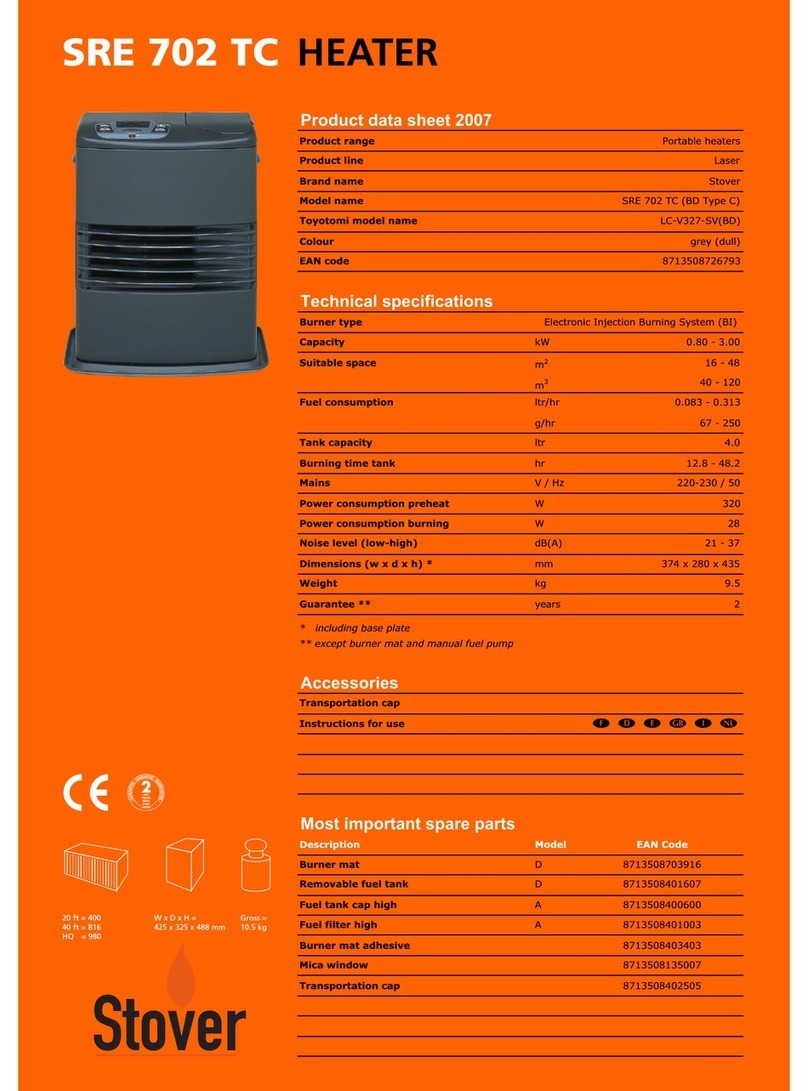
Stover
Stover SRE 702 TC datasheet

SAMES KREMLIN
SAMES KREMLIN MAGMA 500 manual
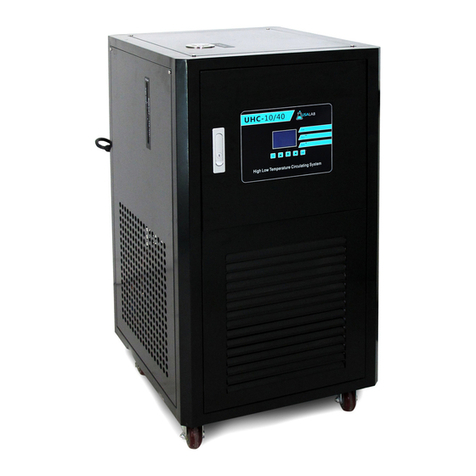
USA Lab
USA Lab UHC Series user manual
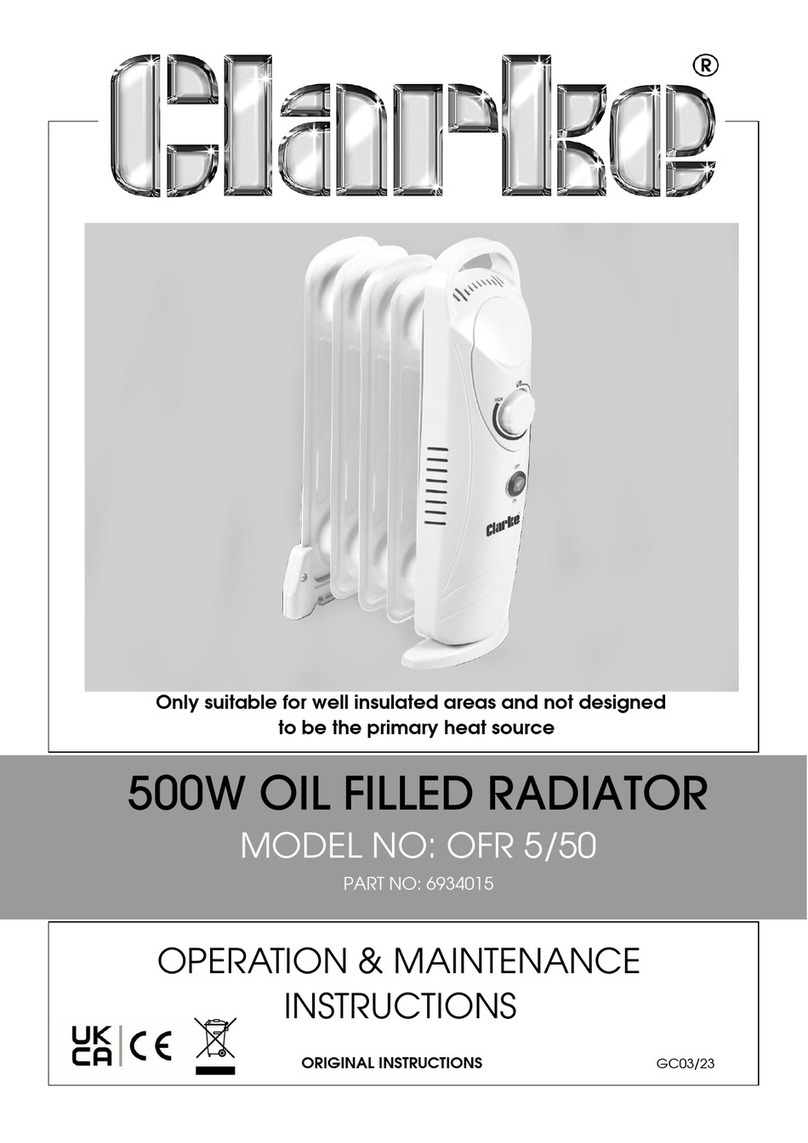
Clarke
Clarke OFR 5/50 Operation & maintenance instructions
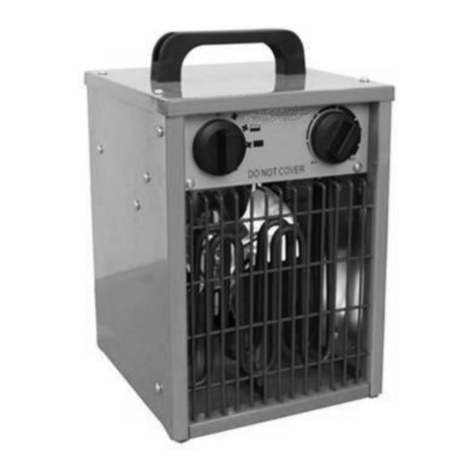
VALERII S & M GROUP
VALERII S & M GROUP PREMIUM-HD 0503EH2KW User's Manual and Operation Instruction
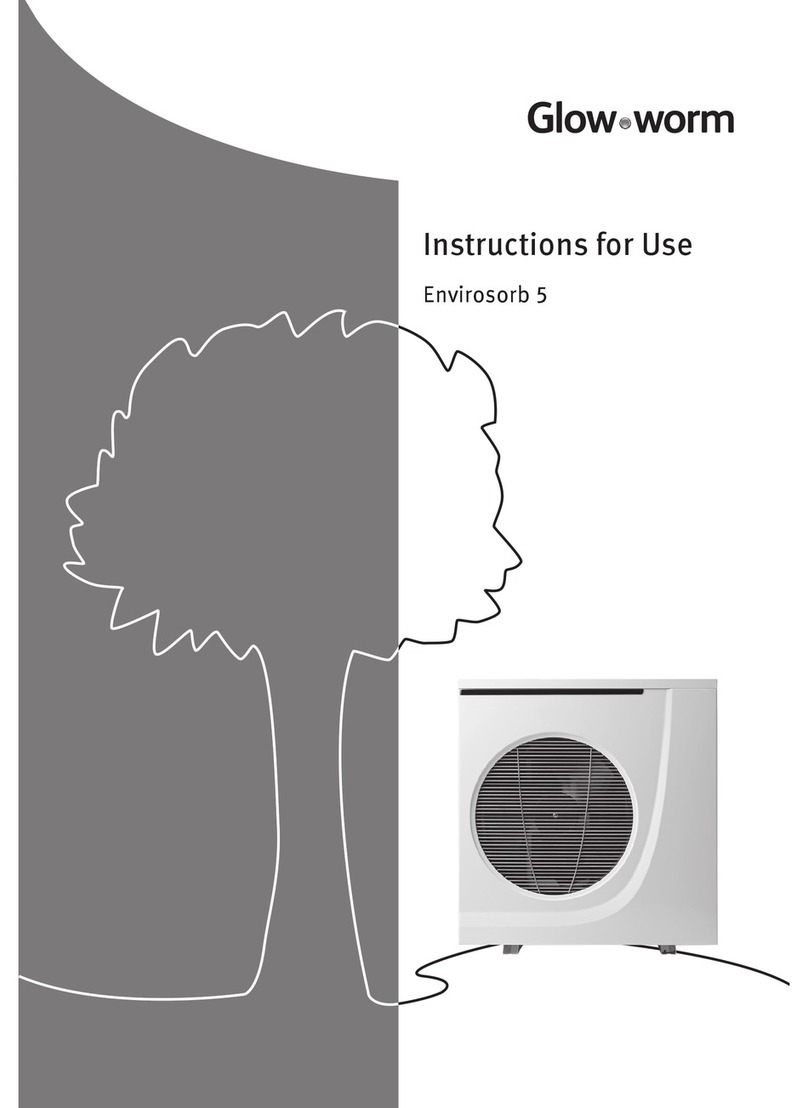
Glowworm
Glowworm Envirosorb 5 Instructions for use
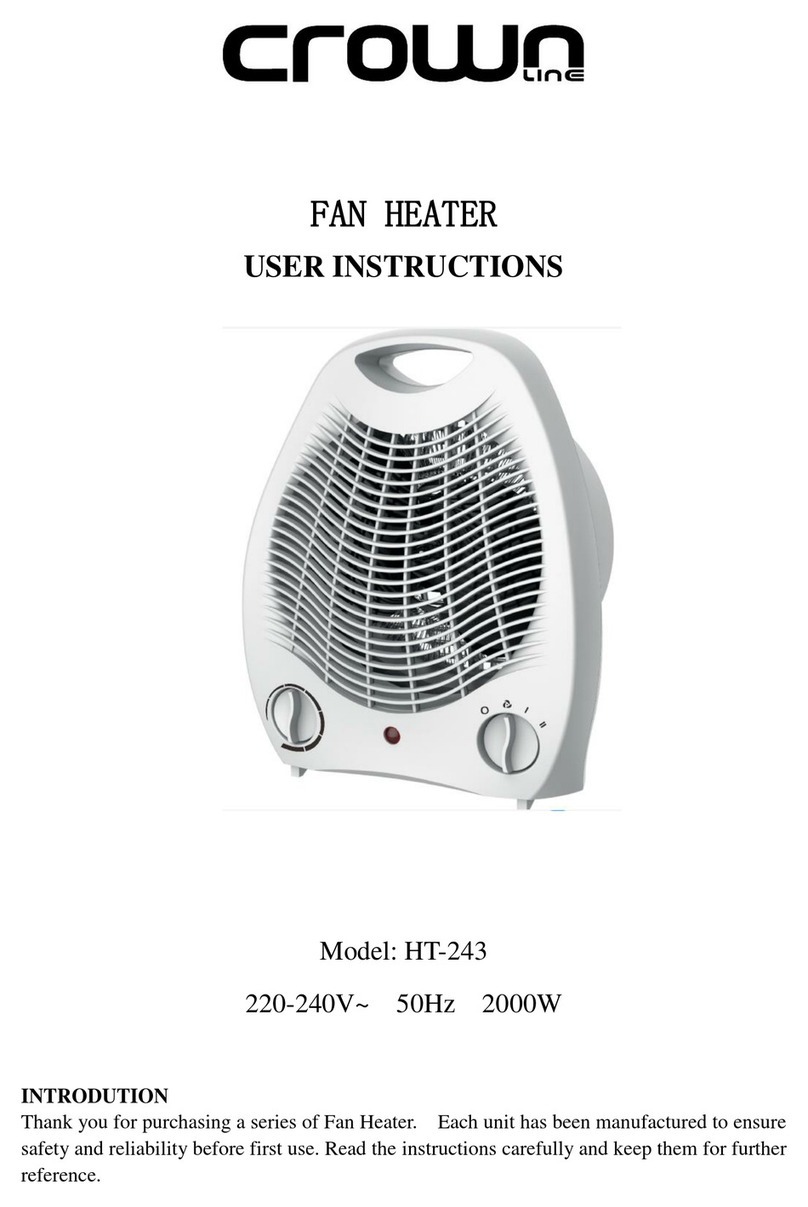
Crownline
Crownline HT-243 User instructions

foc.us
foc.us ATOM 3000 user manual
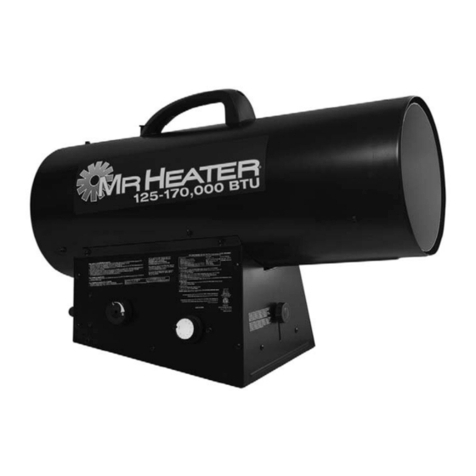
MrHeater
MrHeater MHQ170FAVT Operating instructions and owner's manual
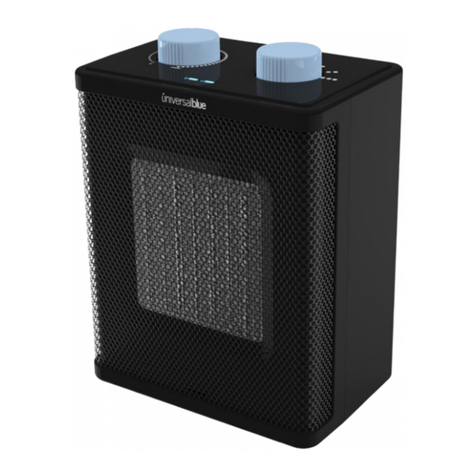
Universal Blue
Universal Blue UCERAMIC1800-19 instruction manual
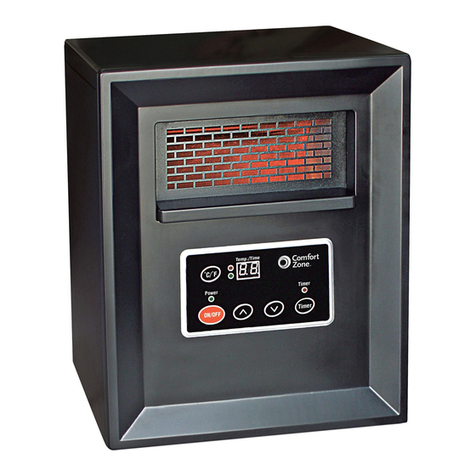
Comfort Zone
Comfort Zone CZ2011P owner's manual
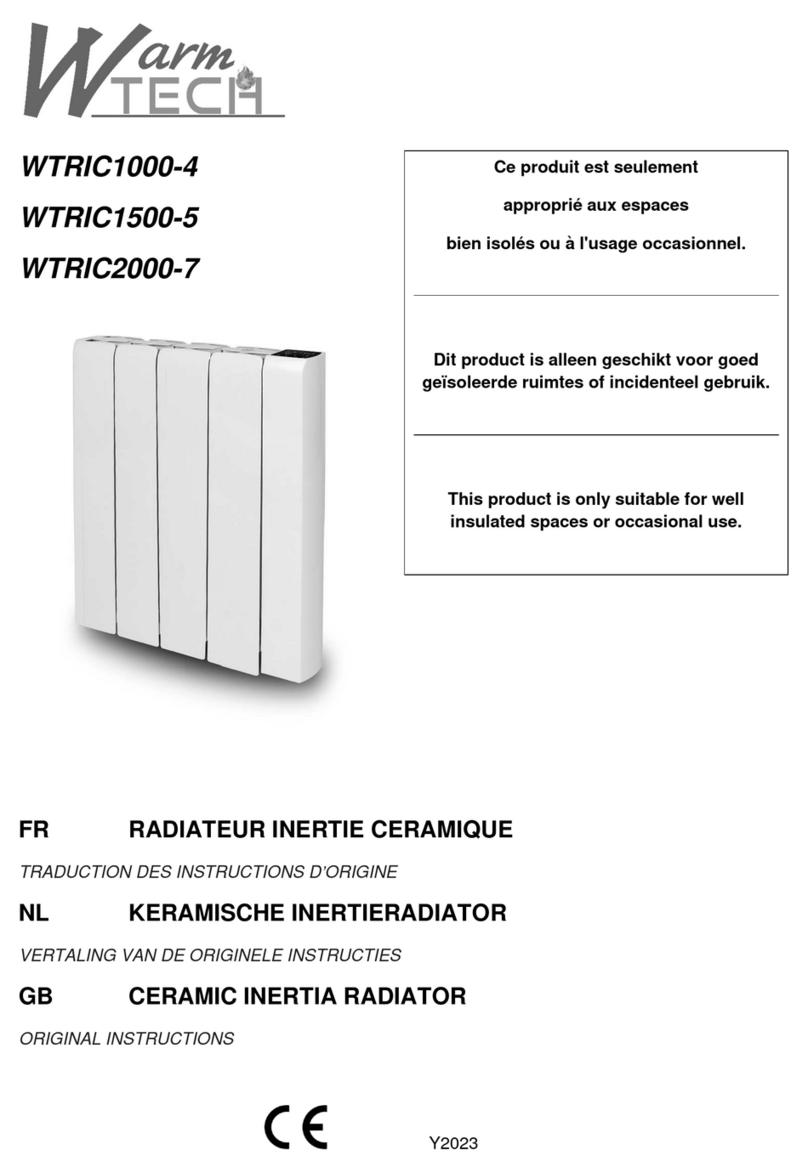
Warmtech
Warmtech WTRIC1000-4 Original instructions


